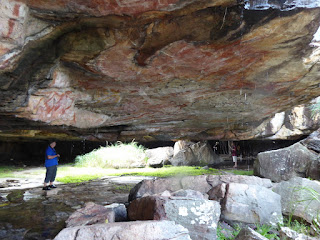Where Stories Are a Matter of Life and Death by Griselda Heppel
Why do we tell stories?
That’s easy – to entertain. To lull our children to sleep. To give
people a way of occupying their minds on long plane journeys. And, of course,
to make a living, if you happen to be the writer of that novel picked up in the
airport bookshop.
It’s not as simple as that, though, is it? Because if
you’re a writer, you can’t help writing, whether or not your stories ever get
published. The urge to tell and listen to stories goes deep into our psyche and
is common to all human societies, no matter how ancient.
This was brought home to me forcefully – and wonderfully –
on a recent visit to Arnhemland in the Northern Territories of Australia, a
region of 37,000 square miles which has been returned by the Australian
Government to its Aboriginal owners, the Yolngu. To visit this beautiful, wild
(and very humid) landscape you need a special permit; or you book, as we did,
with the only safari company allowed to operate there.
Our guide took us on
boat rides through the Cooper Creek billabong, gliding through powder blue water
lilies under dense sawpalm forests and swamp paperbarks, past fields of wild
rice,
landing us in places where we scrambled through thick grass and over
stones to vast overhangs in the rock face, shelters frequented by Aborigines for thousands of years.
And wherever they stayed, there are rock paintings: figures
of men and women, spirits, birds, wallabies, fish, serpents – shapes delineated
not separately but on top of each other, the same surface used over and over again
with older layers of yellow and terracotta-coloured ochre fading under the more
recent (still in terms of hundreds of years!).
This is because the paintings
weren’t made for their own sake: they were done to illustrate stories. The man
(art was strictly a male thing) telling the story would draw as he spoke,
as if the rock face were a blackboard – and the teaching image that evokes isn’t
far from the truth. Adults and children may have enjoyed the stories
but that wasn’t their primary purpose: as Roberts and Parker put it in their
book Ancient Ochres: The Aboriginal Rock
Paintings of Mount Borradaile, ‘Dreaming stories... explain and enshrine
all patterns of living and behaviour, from codifying domestic and inter-clan
socio-economic arrangements to delineating what is edible.’
A scary story about the Rainbow Serpent, for instance,
woken from his sleep by the screaming of a hungry child, whom he promptly
devours along with its mother and the rest of the clan, highlights two
important lessons, according to our guide. First, when moving around the land
gathering food, it’s good to be as quiet as possible; second, mothers need to
give their children plants that will satisfy their hunger, not cause them to
cry more (as was the mother’s mistake in the story).
 |
| The formidable Rainbow Serpent |
Sadly, apart from a magnificent representation of the
Rainbow Serpent on this overhang (clearly an important painting, since –
uniquely in this area – it bore not a trace of other story tellers’ drawing
over it), we found no illustrations of this particular legend. Though if there had been, we wouldn’t be allowed to see them anyway, since Aborigines are
careful about giving away cultural secrets. They don’t mind our seeing these
historic drawings because we don’t know the stories that go with them. Without
the words, the images mean nothing.
 |
| Wallaby sketches |
Well, they knew a thing or two, these ancient peoples. While
literary critics down the ages argue over the ‘moral obligation’ question,
whether the purpose of stories – children’s, especially – should be to foster
virtue and good behaviour in their readers, for the Aborigines, there
were no two ways about it. Stories carried a vital lesson about survival in
their environment: listening well could make the difference between life and
death.
 |
If that isn’t a ringing endorsement for the writer’s and storyteller’s
art, I don’t know what is.






.jpg)

Comments